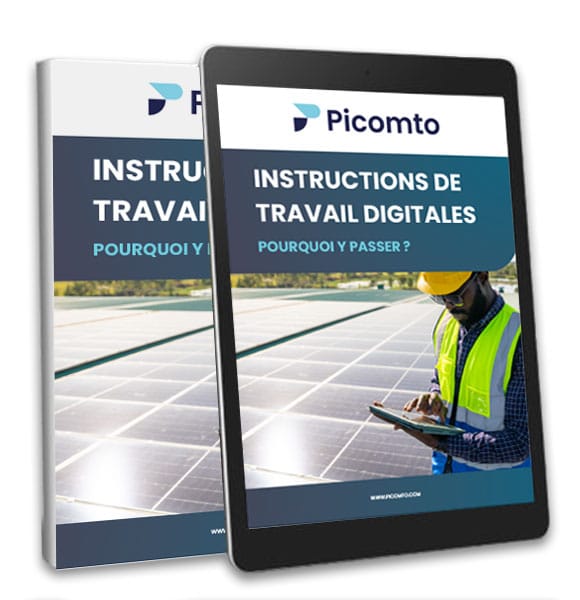How can you guarantee the safety of your industrial facilities against the multiple risks that threaten your operations? This question concerns every industrial executive committed to protecting their workforce and equipment. Industrial risk management today represents a major strategic challenge for any manufacturing enterprise. Indeed, this systematic approach enables the identification, assessment, and control of potential hazards. Furthermore, it ensures operational continuity while preserving personnel safety.
This article provides you with a comprehensive guide to implementing an effective industrial risk management approach within your organization.

Key takeaways regarding industrial risk management:
- Systematic approach: Industrial risk management requires a structured methodology for identification and assessment
- Essential digitalization: Digital tools transform the efficiency of safety procedure management
- Continuous training: Team involvement remains the fundamental pillar of successful prevention
- Permanent improvement: A continuous optimization approach ensures adaptation to regulatory changes
- Demonstrable ROI: Effective risk management generates substantial long-term savings
1. What is industrial risk management and why is it crucial?
Industrial risk management constitutes a fundamental process for any manufacturing enterprise.
This strategic approach aims to effectively protect assets, personnel, and the environment. Moreover, it ensures the sustainability of industrial activity against the inherent dangers of production processes.
1.1. What are the main types of industrial risks?
Industrial risks are divided into several distinct categories, each requiring particular attention:
- Technological risks: explosions, fires, and toxic releases related to industrial processes
- Mechanical risks: accidents caused by industrial equipment and machinery
- Chemical risks: hazards resulting from the handling of dangerous substances
- Biological risks: exposure to pathogenic agents in the work environment
- Psychosocial risks: factors directly impacting employee well-being
Each type of risk requires a specific prevention approach. Thus, precise identification enables the deployment of adequate protective measures.
1.2. What are the stakes of risk management for your enterprise?
Industrial risk management addresses multiple and interconnected challenges that directly impact your performance:
- Employee safety: preservation of physical integrity and prevention of workplace accidents
- Image protection: safeguarding of company reputation and credibility
- Regulatory compliance: adherence to legal obligations and avoidance of sanctions
- Financial optimization: reduction of insurance costs and limitation of operational losses
- Global performance: improvement of competitiveness and organizational efficiency
Discover how our clients have transformed their risk management by consulting our Veolia case study.
2. How to implement an effective industrial risk management approach?
The implementation of an industrial risk management strategy requires a rigorous and structured methodology. This systematic approach enables the identification of all potential hazards and the deployment of appropriate preventive measures.
Nevertheless, success largely depends on the quality of the initial analysis and team engagement.
2.1. What are the key stages of risk assessment?
Risk assessment constitutes the foundation of any effective prevention approach. It is structured around five fundamental stages that must be followed methodically:
- Systematic hazard identification: comprehensive inventory of all risks present on site (chemical, mechanical, thermal, etc.)
- Exposure analysis: detailed assessment of personnel and equipment potentially exposed to each identified hazard
- Criticality evaluation: determination of occurrence probability and severity of consequences for each risk
- Priority ranking: classification of risks according to a criticality matrix to guide actions
- Definition of corrective measures: identification of prevention and protection measures necessary for each risk
This methodical approach guarantees comprehensive coverage of identified risks. However, it requires regular updates to maintain its effectiveness against operational changes.
2.2. How to develop an adapted prevention plan?
The prevention plan concretely translates risk assessment results into operational actions. Its construction follows a progressive logic that integrates all aspects of prevention:
Technical and organizational measures:
- Definition of collective and individual protective equipment
- Specification of intervention procedures and specific safety instructions
- Arrangement of workstations and risk zones
Personnel training and awareness:
- Organization of training sessions adapted to each position
- Continuous awareness of risks and best practices
- Competency certification for critical positions
Emergency situation preparation:
- Planning of evacuation and intervention exercises
- Regular testing of safety equipment
- Implementation of permanent surveillance and control systems
The plan’s effectiveness relies on its ability to adapt to technological and regulatory changes. Thus, periodic revision proves essential to maintain its relevance.
By integrating industrial planning into risk prevention strategies, companies can align safety measures with production objectives, ensuring both operational efficiency and hazard mitigation.
2.3. What tools should be used for daily risk management?
Industrial risk management tools are constantly evolving toward greater digitalization and efficiency. This technological transformation revolutionizes traditional prevention practices.
Evolution of management tools:
- Transition from paper registers to digital solutions
- Replacement of manual dashboards with digital interfaces
- Automation of safety data collection and analysis
Modern technological solutions:
- Integrated CMMS software: risk management modules coupled with maintenance
- Mobile applications: real-time information feedback and reporting
- IoT sensors: automated monitoring of critical parameters (temperature, pressure, etc.)
- Collaborative platforms: information sharing between teams and sites
Operational advantages:
- Facilitation of collaboration between field teams and management
- Automatic generation of regulatory reports
- Complete traceability of prevention actions
- Real-time alerts on risk situations
These modern tools transform risk management by enabling a more proactive and data-driven approach to prevention.
3. How can digitalization optimize industrial risk management?
Digital transformation profoundly revolutionizes traditional approaches to industrial risk management. This technological evolution offers unprecedented opportunities to improve efficiency and responsiveness. However, it requires adaptation of existing processes and skills.

3.1. What are the advantages of a digital approach to risks?
The digitalization of industrial risk management brings numerous tangible benefits that transform industrial practices:
- Improved traceability: precise tracking of all prevention actions undertaken
- Accelerated dissemination: instant transmission of critical information to concerned teams
- Predictive analysis: anticipatory identification of potential failures through digital tools
- Alert automation: automatic notifications in case of anomalies or critical situations
- Documentary centralization: consolidation of regulatory documentation and procedures in one place
This modern approach considerably reduces risks of human error. It also optimizes response times to emergency situations.
3.2. How does Picomto revolutionize safety procedure management?
Picomto radically transforms industrial risk management through its digital work instructions. This innovative platform advantageously replaces traditional paper procedures by offering advanced functionalities:
- Interactive instructions: precise guidance of operators in their critical tasks
- Integrated training modules: continuous reinforcement of skill development
- Automatic traceability system: real-time documentation of all interventions performed
- Updated information dissemination: guaranteed access to the most recent procedures
This revolutionary solution significantly improves regulatory compliance. Consequently, it drastically reduces industrial incidents and accidents.
4. What are the best practices for sustainable industrial risk management?
Excellence in industrial risk management relies on adopting proven and sustainable practices. These methods guarantee continuous improvement of safety performance.
However, their implementation requires strong commitment from management and operational teams.
4.1. How to effectively involve your teams?
Team involvement constitutes the key success factor of a risk management approach. A well-orchestrated engagement strategy transforms each employee into a prevention actor.
Foundations of engagement:
- Transparent communication: clear sharing of safety challenges and prevention objectives
- Continuous training: regular skill development and maintenance of collective vigilance
- Accessible information: provision of tools and resources adapted to each position
Active participation and accountability:
- Involvement in risk analyses: direct participation in assessments at their workstations
- Valued field feedback: encouragement of reports and improvement suggestions
- Shared experience feedback: collective capitalization on incidents and best practices
Recognition and motivation:
- Recognition systems: valorization of exemplary behaviors and safety initiatives
- Delegated responsibilities: appointment of safety representatives in each team
- Individual objectives: integration of safety criteria in performance evaluations
This participatory approach transforms the organization’s safety culture by creating a sense of collective ownership of prevention challenges.
This approach lays the groundwork for a robust Industrial Risk Prevention strategy that adapts to changing environments while promoting a proactive safety culture.
4.2. What strategy should be adopted for continuous improvement?
Continuous improvement of industrial risk management relies on a methodical approach of permanent evaluation and evolution. This strategy ensures constant adaptation to new challenges.
Regular diagnosis and evaluation:
- Periodic audits: systematic evaluation of practices to identify optimization areas
- Incident analysis: thorough investigation of malfunctions to prevent recurrence
- Performance indicators: continuous monitoring of safety KPIs and trend analysis
Surveillance and benchmarking:
- Active regulatory surveillance: constant updating of legal and normative requirements
- Sector benchmarks: comparison with industry best practices
- Professional networks: participation in exchanges between industrialists on safety innovations
Innovation and technological evolution:
- Adoption of new technologies: integration of digital tools to improve prevention
- Pilot projects: experimentation of innovative solutions before general deployment
- Technological partnerships: collaboration with specialized suppliers in safety solutions
This dynamic of permanent evolution maintains system effectiveness while strengthening organizational resilience against new industrial challenges.
Conclusion
Industrial risk management today represents a strategic imperative for any manufacturing enterprise. This systematic approach effectively protects employees, equipment, and the environment while ensuring operational continuity and regulatory compliance.
Benefits of a modern approach:
- Digital transformation: revolution of traditional practices through digital tools
- Enhanced efficiency: significant improvement of traceability and responsiveness
- Sustainable performance: maintenance of operational excellence through continuous team engagement
Adopting a proactive and digital approach is now essential to remain competitive. Picomto accompanies you in this transformation by digitalizing your work instructions and optimizing your risk management processes. Our expertise enables you to make the digital transition with complete confidence.
FAQ
What are the methods of risk management?
Identification, assessment, treatment, and monitoring constitute the four main management methods.
What are the 4 types of risks?
Technological, mechanical, chemical, and biological risks form the four main identified categories.
What is risk management in industry?
Systematic process of identification, assessment, and control of industrial hazards to protect people/assets.
What are the 4 ways to manage a risk?
Avoid, reduce, transfer, or accept constitute the four fundamental treatment strategies.
What is the essential tool for risk management?
Risk assessment remains the fundamental tool enabling identification and prioritization of hazards.
What are the 5 risk families?
Technological, mechanical, chemical, biological, and psychosocial constitute the five main recognized families.
How to manage risks?
Identify, assess, treat, monitor, and regularly review to maintain system effectiveness.
What is the difference between a risk and a hazard?
The hazard represents the potential source, the risk quantifies its probability/severity.






Leave A Comment